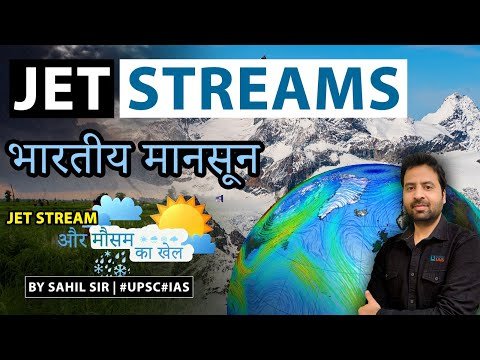Jet Streams: Formation, Types, Distribution and Effects | UPSC
Definition and Characteristics
- Jet Streams are a fast, narrow current of air flowing from west to east that encircles the globe in upper troposphere (about 8-14 kms above Earth’s surface).
- Jet Streams, also known as Rossby Waves, are thousands of kilometers in length and a few hundred kilometers in width and having a vertical thickness of two or more kilometers.
- The mean velocity of Jet Streams is about 144 km/h. However, at times the mean velocity of inner core of Jet Streams may be as high as 480 km/h.
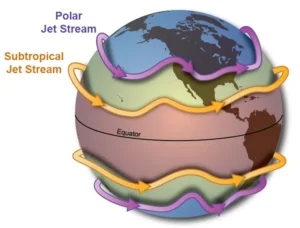
- Jet Streams occur in both the Northern and Southern Hemispheres.
- Since these hot and cold air mass boundaries are most pronounced in winter, Jet Streams are the strongest during both the northern and southern hemisphere
- Jet Streams also “follow the Sun” – they move northward and southward with the apparent movement of the Sun.
-
- In summers they move poleward and in winters they shift equatorward.
-
What causes Jet Streams?
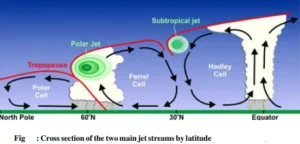
- Jet Streams form when warm air masses meet cold air masses in the atmosphere.
-
- When Earth’s warmer air masses meet cooler air masses, the warmer air rises up higher in the atmosphere while cooler air sinks down to replace the warm air.
- This movement creates an air current, or wind. A jet stream is a type of air current that forms high in the atmosphere.
-
What are the four primary Jet Streams?
- Earth has four primary Jet Streams: two polar Jet Streams, and two subtropical Jet Streams.
- The regions around 30° north and south of equator and 50°-60° north and south of equator are areas where temperature changes are the greatest.
- As the difference in temperature increases between the two locations the strength of the wind increases.
- Therefore, the regions around 30° N/S and 50°-60° N/S are also regions where the wind, in the upper atmosphere, is the strongest.
- The 50°-60° N/S region is where the polar jet is located with the subtropical jet is located around 30°N.
- Earth’s four primary Jet Streams only travel from west to east. So, Jet Streams typically move storms and other weather systems from west to east.
Subtropical Jet Streams Vs Polar Jet Streams
- A subtropical jet is predominantly a high-altitude feature.
- In contrast, eddy-driven Polar Jet Streams are deeper, and it is these specifically, which reach all the way down to the surface.
- The two jets are sometimes separated in latitude (often this is the case over the Atlantic Ocean), but sometimes merged together (as is more common over the Pacific Ocean) forming a broader region of mid-latitude west-to-east winds.
Why do the Jet Streams move from west to east?
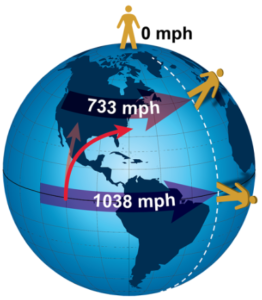
- The rotational speed of the Earth’s surface, and thus the air above it, decreases from equator towards poles.
- As a result, air moving away from the equator does not move directly north and south because it retains this rotational momentum, causing it to rotate faster than the surface below as it moves toward the poles.
- Therefore, as air moves towards the poles, it also moves from west to east relative to the surface. This is the Coriolis effect.
- This Coriolis force deflects the north-south transport of heat from the equator to the poles into the predominantly east-west motion of the jet stream.
Why do Jet Streams not flow in a straight path from west to east?
- The Jet Streams normally do not flow in a straight path from west to east, but rather meander in alternating troughs and ridges. These waves are called Rossby waves.
- There are two major reasons for these non-zonal motions: the temperature gradient between the equator and the poles and the presence of land masses on the earth’s surface.
- The meridional temperature gradient between the equator and poles that gives rise to the jet stream also produces secondary atmospheric circulations, or eddies.
- The eddies modify the distribution of temperature and kinetic energy within the atmosphere, a process that has a pronounced effect on the location and movement of the jet stream.
- And the jet stream itself interacts with these waves, not only as a transport or steering mechanism but also in the transfer of momentum and energy back to the waves.
- The presence of land masses on the earth’s otherwise watery surface modifies the distribution of temperature, because continents heat and cool at a dramatically different rate than do the oceans.
- The topography of the land also influences the jet stream’s location. Mountain ranges and plains on large continents, for example, significantly affect the distribution of atmospheric temperature.
- And since the jet stream is a thermally driven phenomenon, the more complicated the three-dimensional temperature structure of the earth’s atmosphere, the more ‘wandering’ will take place in the course of the jet stream.
How do Jet Streams affect weather?
- Jet Streams play a significant role in determining the weather conditions in lower atmosphere.
- The fast-moving air currents in a jet stream can transport weather systems, affecting temperature and precipitation.
- However, if a weather system is far away from a jet stream, it might stay in one place, causing heat waves or floods.
- Thus, movement of Jet Streams is also important in determining prolonged periods of floods or droughts.
- The path followed by temperate cyclones or mid-latitude weather disturbances are largely controlled by these upper air circulations.
- So, we see that surface meteorological conditions are highly affected by the path of Jet Streams.
- Jet Streams also affect the regularity of monsoonal winds.
Jet Streams and El Nino
- When an El Nino causes excess heating in the tropical Pacific upper atmosphere, the air flow toward the poles becomes more vigorous.
- El Nino tends to lead to an elongated Subtropical Jet Stream that can extend all the way to North America and bring an above-average supply of storms across the southern part of the United States.
How are Jet Streams linked to heatwaves?
- Scientists believe the recent global heatwaves are linked to a strange pattern in the jet stream that has been called “wavenumber 5.”
- When the jet stream forms into a U-bend shape, it can generate heatwaves. Five of these U-bends are currently circling the world in a pattern.
- This pattern is what scientists are calling wavenumber 5, and that it “can persist for weeks, causing hot areas to stay hot for a long time”.
Jet Streams and Indian Weather
a) Subtropical Westerly Jet Stream
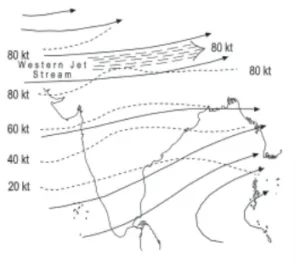
- Over India, the subtropical westerly Jet Stream blows south of the Himalayas (27°-30° north latitude), all through the year except in summer.
- This subtropical westerly jet stream is largely responsible for bringing winter rainfall experienced in the north and north-western parts of the country through Western Cyclonic Disturbances.
- An increase in the prevailing night temperature generally indicates an advance in the arrival of these cyclones disturbances.
- Meteorologists have found an interrelationship between the northward shift of the equatorial trough, also known as the Inter Tropical Convergence Zone (ITCZ), and the withdrawal of the westerly jet stream from over the North Indian Plain.
b) Easterly Jet Stream
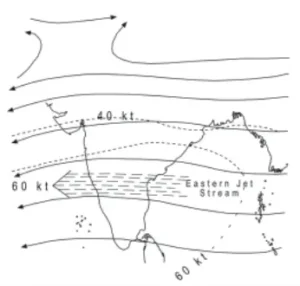
- In summer, the subtropical westerly jet stream moves north of the Himalayas with the apparent movement of the sun.
- An Easterly Jet Stream, called the sub-tropical easterly jet stream blows over peninsular India, approximately over 14-15°N during the summer months.
- This Jet Stream owes its origin to heating of Tibetan plateau due to shifting of Sun’s rays to northern hemisphere.
- This easterly Jet Stream runs from the east coast of Vietnam to the west coast of Africa.
- The easterly jet stream sets in along 15°N latitude only after the western jet stream has withdrawn itself from the region.
- This easterly jet stream is held responsible for the burst of the monsoon in India.
- Around the time of the arrival of south-west Monsoon in India, the normal rainfall increases suddenly and continues constantly for several days. This is known as the ‘burst’ of the monsoon
During Break monsoon conditions Easterly Jet Stream moves northwards up to latitude 20ºN.
- During the south-west monsoon period after having rains for a few days, if rain fails to occur for one or more weeks, it is known as break in the monsoon.
- During the active periods of monsoon, the axis of the Tropical Easterly Jet Stream (TEJ) is located near 5ºN latitude and during break periods it is located around 15ºN latitude.
- Intensity of the Easterly Jet Stream is weak (strong) during El Nino (La Nina) events.
- Besides, a strong Easterly Jet Stream is associated with excess Indian Summer monsoon rainfall and vice-versa.
- The Easterly Jet Stream also steers the tropical depressions into India.
- These depressions play a significant role in the distribution of monsoon rainfall over the Indian subcontinent.
- The tracks of these depressions are the areas of highest rainfall in India.
How do Jet Streams affect air travel?
- Jet Streams are located about 8-14 kms above Earth’s surface in the mid to upper troposphere and generally blow from west to east.
- Airplanes also fly in the mid to upper troposphere. So, if an airplane flies in a powerful jet stream and they are traveling in the same direction, the airplane can get a boost.
- That’s why an airplane flying a route from west to east can generally make the trip faster than an airplane traveling the same route east to west.
Do you know?
- Weather satellites, such as the Geostationary Operational Environmental Satellites-R Series (GOES-R), use infrared radiation to detect water vapor in the atmosphere. With this technology, meteorologists can detect the location of the Jet Streams.
References:
- https://scijinks.gov/jet-stream/
- https://www.scientificamerican.com/article/what-causes-the-high-spee/
- https://www.metoffice.gov.uk/weather/learn-about/weather/types-of-weather/wind/what-is-the-jet-stream
- https://www.weforum.org/agenda/2022/08/jet-stream-winds-fuelling-heatwaves/
- https://www.climate.gov/news-features/blogs/enso/what-jet-stream
- https://www.climate.gov/news-features/blogs/enso/how-enso-leads-cascade-global-impacts
- https://ncert.nic.in/ncerts/l/kegy104.pdf
- https://ncert.nic.in/ncerts/l/iess104.pdf
- https://www.aees.gov.in/htmldocs/downloads/Econtent_aug2020/CLIMATE%20module%202.pdf
Practice Questions:
Q1. With reference to the Jet Streams, consider the following statements:
- These are bands of strong wind in upper stratosphere.
- They meander in relatively narrow belts.
- They generally blow from west to east.
How many of the above statements are correct?
(a) Only one
(b) Only two
(c) All three
(d) None
Answer: b
Explanation:
- Jet Streams are bands of strong wind in upper troposphere (about 8-14 kms above Earth’s surface). (Hence, statement 1 is not correct)
- They meander around the globe in relatively narrow belts, dipping and rising in altitude/latitude. (Hence, statement 2 is correct)
-
- Within Jet Streams, the winds generally blow from west to east, but the band of winds often shifts north and south because Jet Streams follow the boundaries between hot and cold air. (Hence, statement 3 is correct)
-
- Jet Streams are thousands of kilometers in length and a few hundred kilometers in width and having a vertical thickness of two or more kilometers.
-
- The mean velocity of Jet Streams is about 144 km/h. However, at times the mean velocity of inner core of Jet Streams may be as high as 480 km/h.

